Students in the Archives
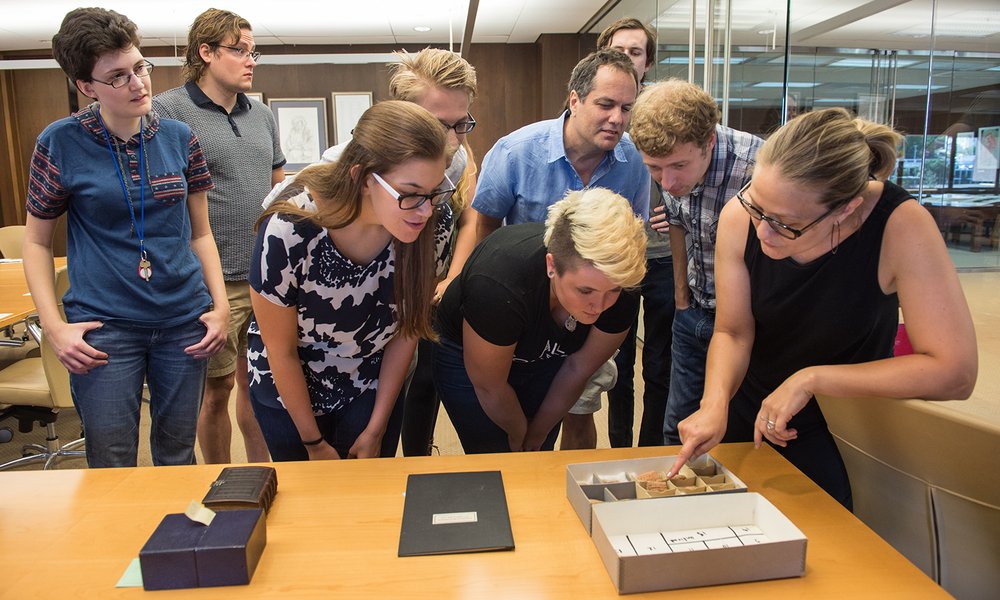
by Patricia Roylance, Associate Professor in the Department of English
In fall 2023 and fall 2024, the undergraduate students enrolled in ENG 407: Advanced Critical Writing had an archival adventure at the Special Collections Research Center (SCRC). This English course, which is subtitled “History of the Book,” has dual aims: to give students training in writing extended research papers while also introducing them to the study of books as material objects within their various contexts of production, circulation and reception. Both aims are achieved through a semester-long archival research project.
The students searched the Libraries’ databases and selected an item of their choosing from the wide-ranging SCRC holdings. In addition to the four projects featured below, project topics included an 1830s legal brief outlining a woman’s bid to seize much of the territory of Utica, New York; a scrapbook documenting the career of a turn-of-the-twentieth-century Syracuse politician; and a pamphlet on reproductive rights originally available at the Genesee Street Planned Parenthood office in the 1970s. Students researched specific editions of classic texts—Pride and Prejudice, Alice’s Adventures in Wonderland, Little Women—and manuscripts from authors such as Allen Ginsberg. Visual culture interested some students, with projects featuring a book of Harvard Lampoon cartoons from the 1870s, 1960s artwork by political cartoonist Robert Bastian, and a 2018 faux-fashion magazine by a Latinx trans artist. Some topics focused on collections that documented the history of student life at Syracuse University, such as the #NotAgainSU student activist movement. The wonderful diversity of the SCRC holdings gave students ample opportunity to find something that deeply interested them.
Once students had selected their archival items, they observed the items closely and learned how to describe both their verbal texts and material forms. The students analyzed how their items’ content and form spoke to one another. They conducted research into the authorial, historical, political and cultural contexts that shaped their items, ultimately presenting their findings in their research papers and in presentations for their classmates and interested Libraries’ staff.
Here are four of the students’ projects, in their own words and accompanied by their own images.
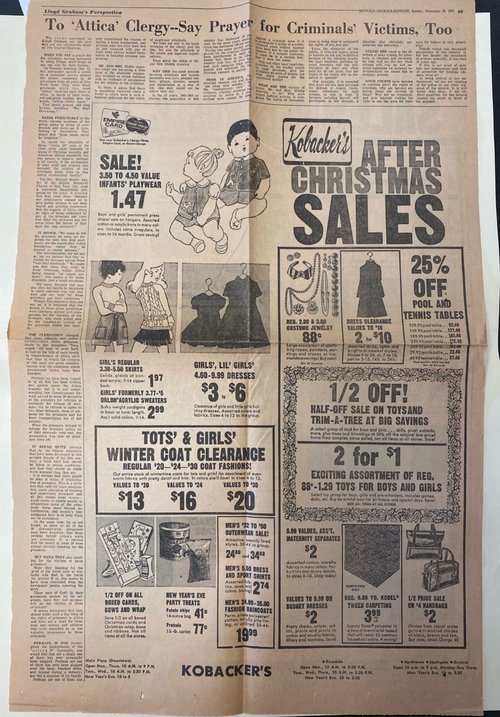
Clipping from the December 26, 1971, issue of the Buffalo Courier-Express containing the article by Lloyd Graham and advertisements for Kobacker’s.
Matt Deckers
Project focus and findings:
For my final research paper for ENG 407: History of the Book, I focused on daily newspaper coverage of the Attica Prison riot of 1971 and examined the ways in which these papers depicted both the revolting prisoners and the correctional institution. I centered my paper around an opinion column by Lloyd Graham in the December 26, 1971, issue of the Buffalo Courier-Express, a local newspaper based in Buffalo, New York, contained in the Attica Prison Uprising Collection in the Special Collections Research Center. Graham’s article frames the prisoners as violent criminals deserving of punishment. I contrasted Graham’s article with pro-prisoner coverage of Attica from radical prison newspapers published in the aftermath of the riot; I found one such paper, a newsletter published by the Prisoners Solidarity Committee, in the Attica Prison Uprising Collection. I wrote that Graham aims to stir fear and resentment of criminals in the piece’s intended audience, the heteronormative white American family unit (referred to as “Mr. and Mrs. Middle America” throughout the article). Furthermore, I found that Graham’s vitriolic rhetoric is emblematic of rising public punitiveness towards prisoners in 20th-century America, which is reflected in racist and spectacle-oriented coverage of the Attica Prison riot by daily newspapers.
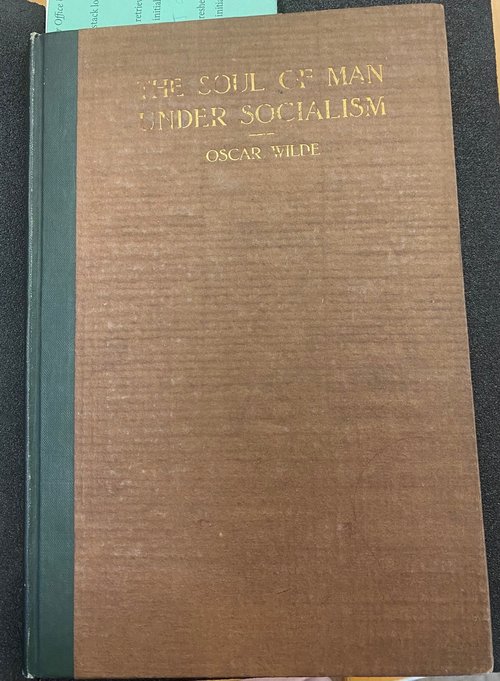
The Soul of Man under Socialism, written by Oscar Wilde and published in 1910 by John W. Luce and Company. The exterior cover is an earthy, muted brown, accented by a deep green spine and the dull glow of gilt lettering. A political essay, the work advocates for the instatement of socialism.
Aria DeMarco
Item: Oscar Wilde, The Soul of Man under Socialism (Boston, 1910).
Project focus and findings:
Granted the opportunity to work with an item from Special Collections, I selected The Soul of Man under Socialism, an essay written by Oscar Wilde and published as a book by John W. Luce and Company in 1910. Though the essay advocated for the instatement of socialism, a social and political system that seeks to equalize, diminishing class distinctions and placing the power of production in the hands of the masses, my work with the book revealed a central tension between its stated political aims and elitist elements of both its text and paratext. In order to identify and further tease out the paradox that lay at its core, I engaged in external research and close analysis of the book’s language. Through careful consideration of Wilde’s rhetoric, I was able to identify his tendency to depict the plight of the working classes as a mere disruption to the public sphere and to admonish poverty as an inconvenience to the comparatively wealthy. His perspective on class-based struggles appeared to be shaped by an underlying belief in the superiority of the affluent, and it is this belief, revealed through the essay’s rhetorical elements, that undermined its larger socialist aims. In addition to conducting a close textual analysis of the book, I endeavored to explore the implications of its paratextual characteristics. This process led to revealing discoveries regarding the book’s seller and publisher, two entities which, in their exclusive, class-targeted marketing strategies, echoed and modified the specific form of elitism communicated in the book’s textual content. As a result of a comprehensive research process, supported by the wonderful Professor Roylance, the key tensions of The Soul of Man under Socialism were drawn forth, revealing an ideological complexity that marked the work and, at times, undermined its core political message.

The title page of The Astrologer of the Nineteenth Century shows the complete title of the book. Underneath the title, an illustration of a key resting on top of a book next to the nameplate “Raphael” is detailed with colors.
Adrianna Lora
Item: Robert Cross Smith (Raphael), The Astrologer of the Nineteenth Century, or the Master Key of Futurity (London, 1825).
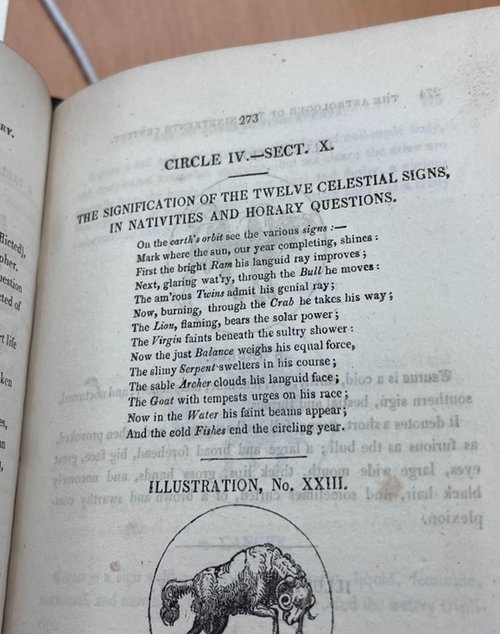
A poem representing the different archetypes of the Zodiac starting with the Ram (Aries) and ending with the Fishes (Pisces). This is a precursor to a thorough explanation of the 12 Zodiac signs.
Project focus and findings:
The Astrologer of the Nineteenth Century is a book written by Robert Cross Smith, a practicing astrologer during the 1800s. This book is an amalgamation of a periodical Smith published, and it discusses various occult practices such as necromancy and spiritualism, geomancy, talismans, and rituals. Smith excels in his explanations and lessons about astrology and future predictions using the stars. His astrologer teachings include explanations of the Zodiac signs, the planets, and how to calculate a star chart of any moment in time. Occult interest was steadily rising in 1825 with ghost stories and sightings passing from town to town. The book capitalizes on this intrigue and attempts to satisfy the curiosity of Smith’s audience; it contains over ninety dramatic illustrations that try to capture occult mysticism. From its detailed explanations of religious rituals to different astrological prophecies, this book explains an array of taboo practices and how the reader can implement them. The Astrologer of the Nineteenth Century is not only a worthwhile text to understand early Victorian perspectives on occult matters, but it is also a fascinating read that stokes the imagination.
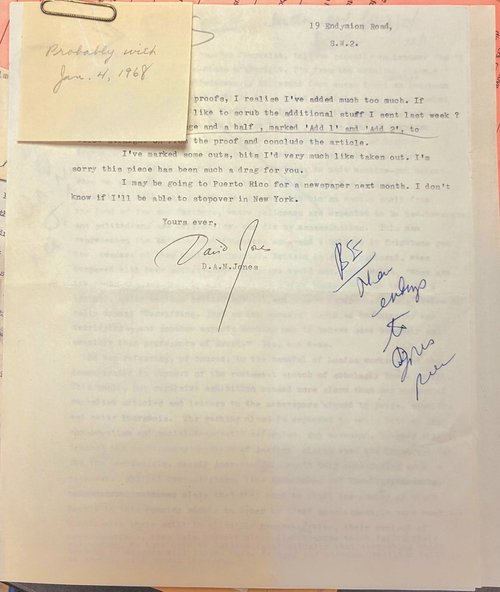
Page 1 of the item, D.A.N. Jones’s letter to Bob Silvers, with archival note paperclipped to top-left corner.
Roslyn Lydick
Item: D.A.N. Jones Letter in New York Review of Books Records

Page 2 of the item, a typewritten manuscript of a new ending to one of Jones’s pieces for the Review. There are pencil and pen edits directly on the text and a few notes in the margins. A notable detail is situated on the top margin, where co-editor Barbara Epstein has written “much better end for Jones,” right next to which is a note that reads “Not used.”
Project focus and findings:
The object I wrote about consists of (1) a short typewritten letter from British writer David (D.A.N.) Jones to New York Review of Books co-editor Bob Silvers explaining that he has attached a page and a half of manuscript as edits to an already-written piece, (2) a page of typewritten manuscript with edits and notes added by NYRB staff, (3) a photocopy of that page taken at some point before the manuscript had accumulated all of its edits, and (4) a small handwritten archival note paperclipped to the top-left corner where the other three pages are stapled together. I was interested in how this letter and political book review manuscript gained contextual layers over time: first gaining the additional status of being a site of internal communications, then becoming an archival object in the NYRB archives, before finally (so far) gaining new cultural and technological significance as an archival object of the university’s Special Collections archive. My essay explores the question of “what happens to political texts once they are archived?” by engaging this object in a political critique of the mechanisms by which collective cultural memory is created, archived and often lost—to time, inaccessibility and unjust representation of marginalized voices in the archive. Though the manuscript I studied never even made it to a final printing in the New York Review of Books, its existence in Special Collections is an insistence on its cultural importance—an insistence that is worth examining as we endeavor to create better, more equitable institutions for keeping cultural memory alive.
